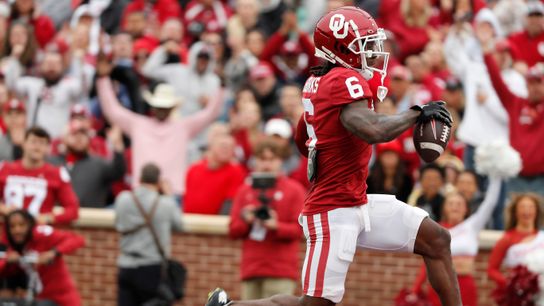
Deion Burks
height
5'11"
weight
195
position rank
13
overall rank
78
team
Oklahoma
conference
SEC

2024 STATS
Based on 5 games played
31Rec
245Rec Yards
3TDs
7.9Y/R
Top Traits
Deion Burks Scouting Report
Deion Burks is an electric playmaker who can win vertically up the field or by taking short passes and converting them to big offensive plays.
Draft Grade: Round 2 - Winning Starter
Strengths:
Big-Play Threat: Burks has the top-end speed and acceleration to create an explosive play at any moment.
Elusiveness: Burks has elite short-area quickness. Burks can make the first defender miss with ease and is a dangerous run-after-catch receiver.
Versatility: Burks has the athletic profile to align all over the field and even at running back to be an impact player.
Concerns:
Catch Radius: Burks is limited in overall size and length, which affects his catch radius and ability to make catches with defenders who are in phase with him.
Size: Because Burks is an undersized wide receiver, NFL teams may limit the roles he can fill and make him a primary slot and/or gadget receiver.
Deion Burks Summary/Projection:
Deion Burks transferred from Purdue to Oklahoma after putting together a strong season in 2023. His first season at Oklahoma (2024) was slowed by injury. Burks presents as a quick vertical threat who uses his speed to dictate matchups with defenders. He is an alignment-versatile player whose frame lends itself to a primary slot role; however, he also shows an understanding of how to win on the outside and can consistently line up there and win his reps.
Burks showcases different releases depending on his alignment and the coverage he sees. Against press-man, he’s at his best when using quickness and speed to win early. He can dip his shoulder to avoid contact, and once even with the defender, he has the acceleration to stack vertically up the field. Against off coverage, Burks can tempo his routes and understands how to stem defensive backs to gain leverage for his breaks and create separation. Burks is a high-IQ player who understands how his releases translate into route-running success. It’s in his route-running where Burks truly stands out—he accelerates and decelerates with ease and is a tough cover for defenders. He can stop on a dime and change direction quickly to separate at the top of routes.
Burks has good hands and appears to be a natural hands-catcher. He can make difficult catches, showing the ability to adjust to the ball and contort his body. On vertical routes, Burks tracks the ball well over his shoulder and can catch without breaking stride. He is a skilled receiver with natural physical tools, and it’s clear he invests in the technical details required to become a complete receiver.
The main concerns with Burks as a prospect are tied to his size. Against tight man coverage, when defenders stay in phase, they can break up passes due to his limited length and catch radius, which prevents him from consistently making catches away from his frame. Another concern is that, while Burks has shown flashes of high-level play on the outside, there are moments when corners with good foot quickness and length disrupt his release at the line of scrimmage, making it difficult for him to get into his route.
Overall, Burks has the physical profile and technical foundation to be a dynamic playmaker at the next level—especially if utilized in the right system.

